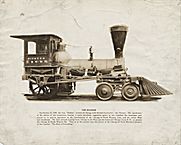Chicago is the most important railroad center in North America. More lines of track radiate in more directions from Chicago than from any other city. Chicago has long been the most important interchange point for freight traffic between the nation's major railroads and it is the hub of Amtrak, the intercity rail passenger system. Chicago ranks second (behind New York City) in terms of the volume of commuter rail passengers carried each day.
The first railroad in Chicago was the Galena & Chicago Union, which was chartered in 1836 to build tracks to the lead mines at Galena in northwestern Illinois. The first tracks were laid in 1848, and then not to Galena but to a point known as Oak Ridge (now Oak Park). The Galena & Chicago Union's terminal stood near the corner of Canal and Kinzie Streets.
 |
Later lines connected the city with Detroit, Cleveland, Cincinnati, New Orleans, St. Louis, Kansas City, Omaha, and St. Paul. Railroads were especially important as haulers of grain and livestock, which helped Chicago gain a primary role in the grain marketing andmeatpacking industries.
Many of the railroads built west of Chicago had their corporate headquarters in the city, as well as yards and shops. Chicago became a center for the manufacture of freight cars, passenger cars (Pullman Company), and, later diesel locomotives (Electro-Motive Division of General Motors, in La Grange).
Although the nation's railroads now have been merged into just a few large systems, Chicago remains the hub where the tracks of one company end and those of another begin. Until the 1960s the Chicago Loop contained six major railroad terminals for intercity rail passenger traffic. Passengers traveling between the East and West Coasts often had half a day to spend in Chicago between trains and took advantage of the time by sightseeing. Journalists sometimes met trains arriving from New York or Los Angeles to spot the celebrities. The decline of intercity rail passenger travel brought about by the advent of jet airlines led to the decline of the passenger train and the eventual consolidation of remaining services under Amtrak in 1971.
Read the full article at:
Railroads - Encyclopedia of Chicago
www.encyclopedia.chicagohistory.org/pages/1039.html
Images for chicago railroads
- Report images
CHICAGO'S RAILROADS - chicago transit & railfan
www.chicagorailfan.com/watching.html
CHICAGO'S RAILROADS. This complex network of railroads in the railroad center of the nation, can be a challenge to untangle. But this information will help sort ...- Chicago is the most important railroad center in North America. More lines of track radiate in more directions from Chicago than from any other city. Chicago has ...
Galena and Chicago Union Railroad - Wikipedia, the free ...
en.wikipedia.org/wiki/Galena_and_Chicago_Union_Railroad
The Galena and Chicago Union Railroad (G&CU) was a railroad running west fromChicago to Clinton, Iowa and Freeport, Illinois, never reaching Galena, ...
Chicago and Eastern Illinois Railroad - Wikipedia, the free ...
en.wikipedia.org/wiki/Chicago_and_Eastern_Illinois_Railroad
The Chicago and Eastern Illinois Railroad (reporting mark CEI) was a Class Irailroad that linked Chicago to southern Illinois, St. Louis, and Evansville. Founded...
Chicago Railroad Fair - Wikipedia, the free encyclopedia
en.wikipedia.org/wiki/Chicago_Railroad_Fair
The Chicago Railroad Fair was an event organized to celebrate and commemorate 100 years of railroad history west of Chicago, Illinois. It was held in Chicago ...
List of Illinois railroads - Wikipedia, the free encyclopedia
en.wikipedia.org/wiki/List_of_Illinois_railroads
Atchison, Topeka and Santa Fe Railroad in Chicago · ATSF, 1887, 1902, Atchison, Topeka and Santa Fe Railway · Atchison, Topeka and Santa Fe Railway ...
Chicago, Burlington and Quincy Railroad - Wikipedia, the free ...
en.wikipedia.org/wiki/Chicago,_Burlington_and_Quincy_Railroad
The Chicago, Burlington and Quincy Railroad (reporting mark CBQ) was a railroadthat operated in the Midwestern United States. Commonly referred to as the ...
The City Transformed: Railroads and Their Influence on the Growth
www.hcs.harvard.edu/~dreyfus/history.html
In 1850, only one railroad passed through Chicago. The Galena & Chicago UnionRailroad, which never actually reached Galena, was opened in 1848.
Chicago Rail Junctions - Doug's Railroad Place
dhke.com/CRJ/
An in-depth look at some busy rail crossings in the Chicago area and northwest Indiana.
Chicago South Shore & South Bend Railroad
www.southshorefreight.com/
Chicago South Shore and South Bend Railroad is a strategically located shortline carrier connecting Northern Indiana's industrial areas with 20 transcontinental, ...

